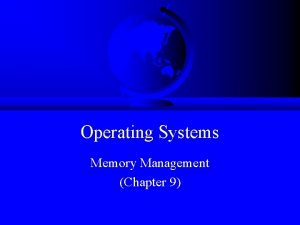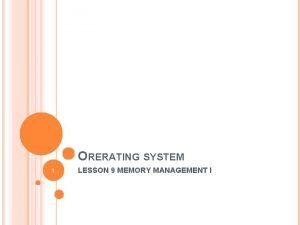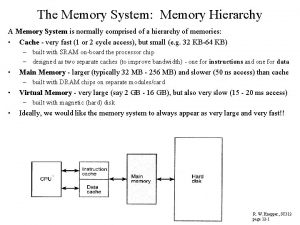ORERATING SYSTEM 1 LESSON 10 MEMORY MANAGEMENT II














- Slides: 14

ORERATING SYSTEM 1 LESSON 10 MEMORY MANAGEMENT II

PAGE REPLACMENT ALGORITHMS When a page fault occurs, the operating system has to choose a page to remove from memory so that making a room for the page that has to be brought in. If the removed page has been modified while in memory, it must be rewritten to the disk. If the page has not been changed, the disk copy is already up to date, so no rewrite is needed. 2

System performance is much better if a page that is not heavily used is chosen to evict at each page fault. The problem of “page replacement” occurs in other areas of computer design as well. For example, memory caches… When the cache is full, some block has to be chosen for removal. This problem is precisely the same as page replacement except on a shorter time scale. It has to be done in a few nanoseconds, not milliseconds as with page replacement. 3

THE OPTIMAL PAGE REPLACEMENT ALGORITHM The best possible page replacement algorithm is easy to describe but impossible to implement. At the moment that a page fault occurs, some set of pages is in memory. One of these pages will be referenced on the very next instruction (the page containing that instruction). Other pages may not be referenced until 10, 100, or perhaps 1000 instructions later. Each page can be labeled with the number of instructions that will be executed before that page is first referenced. The optimal page algorithm simply says that the page with the highest label should be removed. Although this method is useful for evaluating page replacement algorithms, it is of no use in practical systems. 4

THE NOT RECENTLY USED (NRU) PAGE REPLACEMENT ALGORITHM Most computers with virtual memory have two status bits associated with each page. R is set whenever the page is referenced (read or written). M is set when the page is written to (i. e. , modified). 5

When a page fault occurs, the operating system inspects all the pages and divides them into four categories based on the current values of their R and M bits: � Class 0: not referenced, not modified. � Class 1: not referenced, modified. � Class 2: referenced, not modified. � Class 3: referenced, modified. The NRU (Not Recently Used) algorithm removes a page at random from the lowest numbered nonempty class. Implicit in this algorithm is that it is better to remove a modified page that has not been referenced in at least one dock tick (typically 20 msec) than a clean page that is in heavy use. 6

THE FIRST-IN, FIRST-OUT (FIFO) PAGE REPLACEMENT ALGORITHM The operating system maintains a list of all pages currently in memory. The oldest page is kept at the head of list and the most recent arrival page is kept at the tail of list. On a page fault, the page at the head is removed and the new page added to the tail of the list. FIFO in its pure form is rarely used since it removes some of the most used pages. 7

THE SECOND CHANCE PAGE REPLACEMENT ALGORITHM A simple modification to FIFO is made by checking the R bit of the oldest page. If R bit is 0, the page is both old and unused, so it is replaced immediately. If the R bit is 1, the bit is cleared, the page is put onto the end of the list of pages, and its load time is updated as though it had just arrived in memory. Then the search continues. The operation of this algorithm, called second chance. We see pages A through H kept on a linked list and sorted by the time they arrived in memory. 8

THE CLOCK PAGE REPLACEMENT ALGORITHM Although second chance is a reasonable algorithm, a better approach is to keep all the page frames on a circular list in the form of a clock. A hand points to the oldest page 9

THE LEAST RECENTLY USED (LRU) PAGE REPLACEMENT ALGORITHM A good approximation to the optimal algorithm is based on the observation the pages that have been heavily used in the last few instructions will probably be heavily used again in the next few. Conversely, pages that have not been used for ages will probably remain unused for a long time. This idea suggests a realizable algorithm: when a page fault occurs, throw out the page that has been unused for the longest time. This strategy is called LRU (Least Recently Used) paging. 10

This method requires equipping the special hardware with a 64 -bit counter, C, that is automatically incremented after each instruction. Furthermore, each page table entry must also have a field large enough to contain the counter. After each memory reference, the current value of C is stored in the page table entry for the page just referenced. When a page fault occurs, the operating system examines all the counters in the page table to find the lowest one. That page is the least recently used. 11

SIMULATING LRU IN SOFTWARE Instead of using a special hardware for page replacement, a solution that can be implemented in software is needed. One possibility is called the NFU (Not Frequently Used) algorithm. It requires a software counter associated with each page, initially zero. At each clock interrupt, the operating system scans all the pages in memory. For each page, the R bit, if it is 1, is added to the counter. In effect, the counters are an attempt to keep track of how often each page has been referenced. When a page fault occurs, the page with the lowest counter is chosen for replacement. 12

THE WORKING SET PAGE REPLACEMENT ALGORITHM The set of pages that a process is currently using is called its working set. If the entire working set is in memory, the process will run without causing many faults until it moves into another execution phase (e. g. , the next pass of the compiler). Therefore, many paging systems try to keep track of each process‘ working set and make sure that it is in memory before letting the process run. This approach is called the working set model. It is designed to greatly reduce the page fault rate. Loading the pages before letting processes run is also called prepaging. Note that the working set changes over time. 13

14
 Semantic knowledge
Semantic knowledge Explicit memory
Explicit memory Long term memory vs short term memory
Long term memory vs short term memory Internal memory and external memory
Internal memory and external memory Primary memory and secondary memory
Primary memory and secondary memory Physical address vs logical address
Physical address vs logical address Which memory is the actual working memory?
Which memory is the actual working memory? Virtual memory and cache memory
Virtual memory and cache memory Virtual memory in memory hierarchy consists of
Virtual memory in memory hierarchy consists of Eidetic memory vs iconic memory
Eidetic memory vs iconic memory Symmetric shared memory architecture
Symmetric shared memory architecture Address binding
Address binding Lesson 2 muscle storyboard
Lesson 2 muscle storyboard Bepin choudhury lapse of memory learning objectives
Bepin choudhury lapse of memory learning objectives Belady's anomaly example
Belady's anomaly example


























